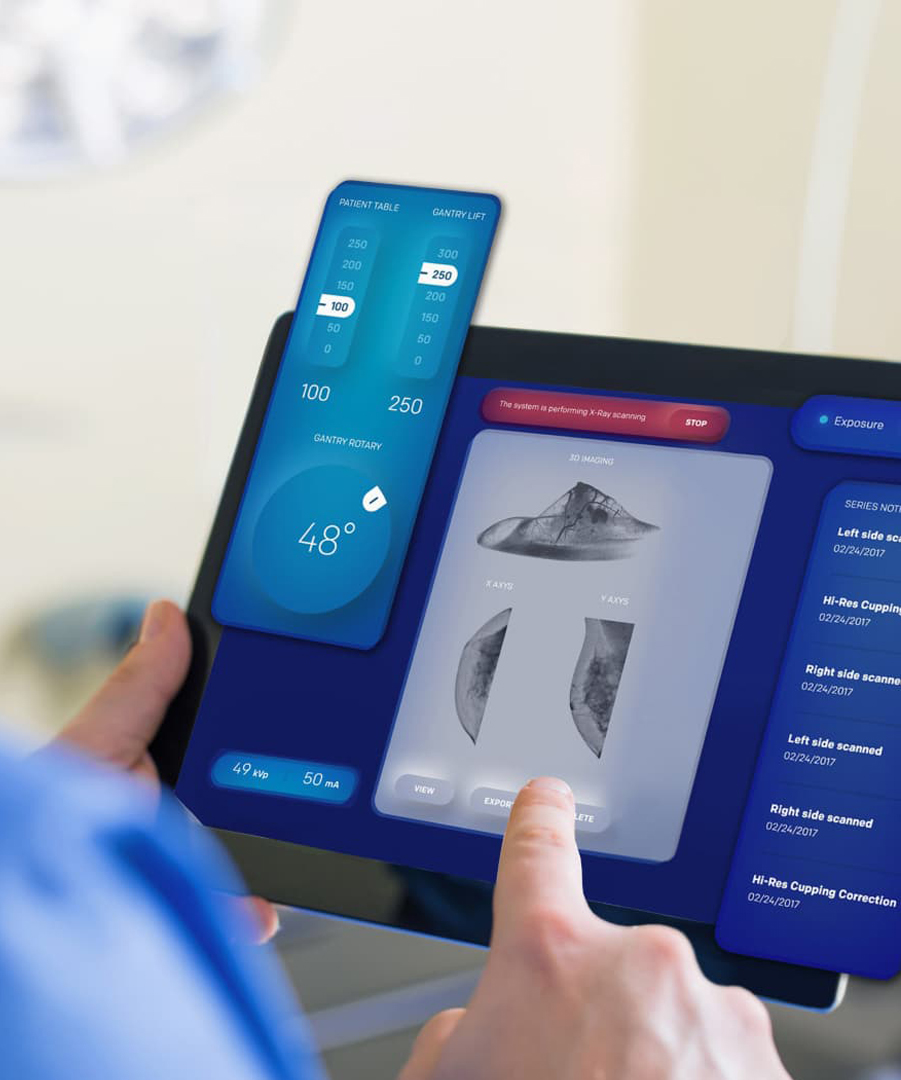


รถบรรทุกน้ำดับเพลิง หมายถึง รถดับเพลิงที่ติดตั้งบูมแบบพับได้หรือแบบพับได้พร้อมบูมแบบยืดหดได้ แท่นหมุน และอุปกรณ์ดับเพลิง นักดับเพลิงสามารถควบคุมหัวฉีดดับเพลิงที่ด้านบนของบูมจากพื้นดินจากระยะไกลเพื่อทำการดับเพลิงทางอากาศ บทความนี้จะกล่าวถึง รถดับเพลิงหอส่งน้ำ HOWO เพื่อเป็นตัวอย่างแนะนำการใช้งานและโครงสร้าง
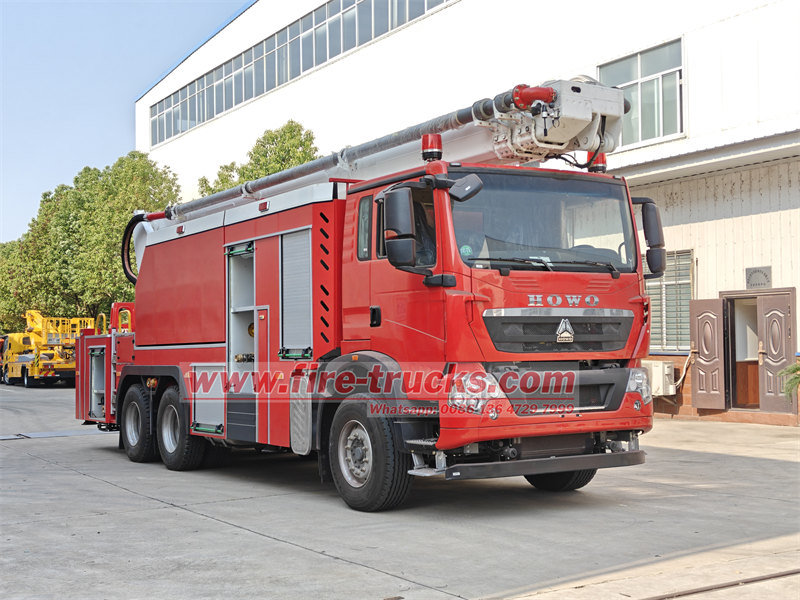
1) การใช้งาน
การ
รถดับเพลิงหอส่งน้ำ HOWO
มีคุณสมบัติเด่นดังนี้:
1. ความสามารถในการปฏิบัติงานที่โดดเด่น:
คุณสมบัติความสามารถในการทำงานช่วงกว้างพิเศษ ช่วยให้สามารถดับเพลิงแบบประสานงานสามมิติ และดับเพลิงเป้าหมายในระยะใกล้พิเศษได้
2. ความสามารถในการใช้ที่กว้างขวาง:
ระยะปฏิบัติการกว้าง ความสามารถในการข้ามสิ่งกีดขวางที่แข็งแกร่ง และการทำงานที่ยืดหยุ่น
3. ฟังก์ชันการทำงานที่ครอบคลุม:
บูรณาการการกู้ภัยที่สูงและการดับเพลิงที่ความสูงต่ำ โดยมีความสามารถในการพ่นน้ำและโฟม
4. ประสิทธิภาพที่เหนือกว่า:
พื้นที่ดับเพลิงสูงและมีความสามารถในการระบายน้ำขนาดใหญ่
การใช้งานหลักๆ ได้แก่:
• การดับเพลิงในสถานประกอบการอุตสาหกรรมและเหมืองแร่
• ไฟไหม้โรงงานปิโตรเลียมและสารเคมี
• ไฟไหม้ถังน้ำมันและโกดังสินค้า
• ไฟไหม้อาคารขนาดใหญ่
ประเภทภัยพิบัติที่สามารถนำไปใช้ได้:
• ไฟไหม้อาคารสูง
• ไฟไหม้ในพื้นที่ช่วงกว้าง
• ไฟไหม้จากปิโตรเลียมและสารเคมี
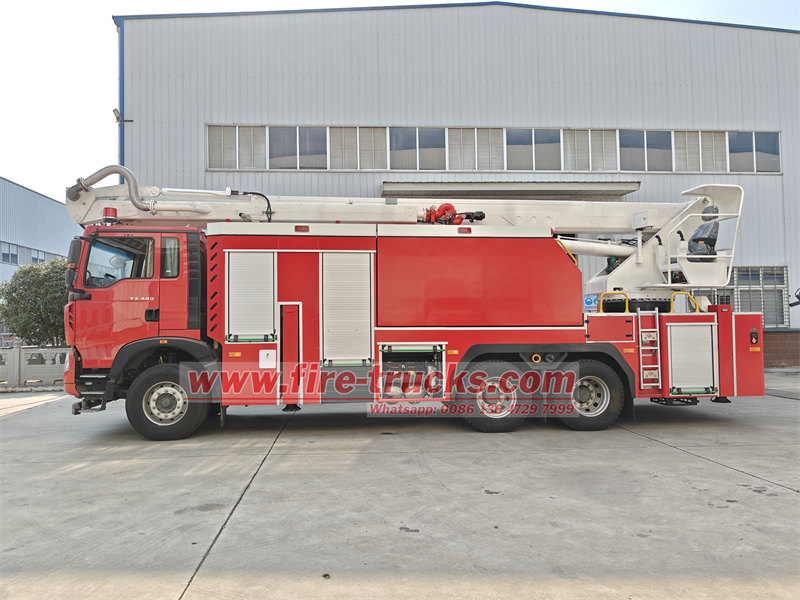
2) องค์ประกอบโครงสร้าง
การ
หอส่งน้ำ HOWO
ใช้การออกแบบบูมแบบพับได้ ช่วยให้หมุนได้รอบทิศทาง กลไกทั้งหมดขับเคลื่อนด้วยระบบไฮดรอลิกและควบคุมด้วยระบบไฟฟ้า ใช้งานง่าย รวดเร็ว ราบรื่น และมีความน่าเชื่อถือสูง ตัวรถติดตั้งถังบรรจุของเหลว ปั๊มดับเพลิง และระบบควบคุมระยะไกลที่ควบคุมด้วยระบบไฟฟ้าที่ด้านบนของบูม ซึ่งมีระยะการทำงานที่ไกลและอัตราการไหลที่มาก รองรับโหมดการดับเพลิงหลากหลายรูปแบบ ได้แก่ การฉีดน้ำตรง การฉีดน้ำ การฉีดน้ำแรงดันสูง และการฉีดพ่นโฟม
1. กลไกการสนับสนุน
ขาตั้งเสาใช้โครงสร้างแบบ H ที่ทำจากเหล็กอัลลอยด์โปรไฟล์ที่มีความแข็งแรงสูง ช่วยให้มั่นใจได้ถึงความปลอดภัยและความน่าเชื่อถือ
2. โครงสร้างบูม
บูมนี้สร้างขึ้นจากแผ่นเหล็กกล้าอัลลอยด์ความแข็งแรงสูงผ่านการดัดและเชื่อมแบบเย็น ประกอบด้วยส่วนพับสามส่วน ขับเคลื่อนด้วยกระบอกสูบไฮดรอลิกเพื่อการใช้งาน
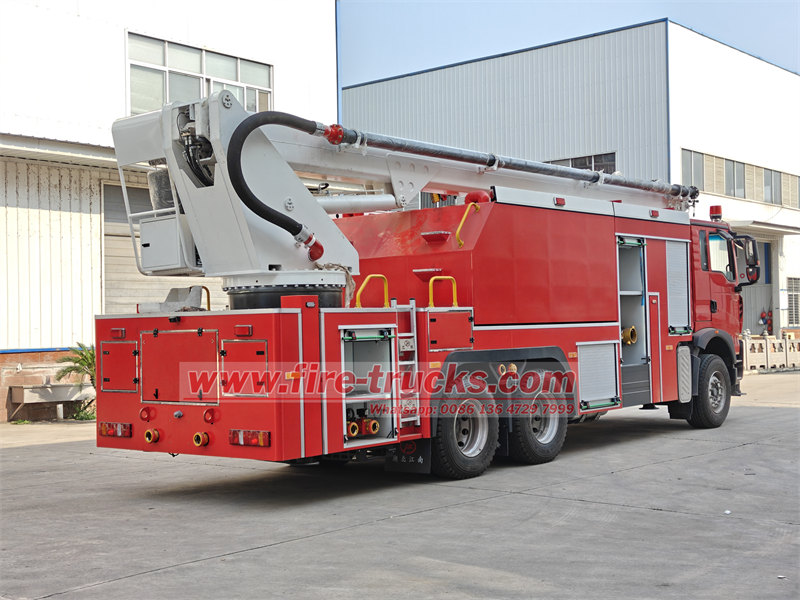
3. คอนโซลการทำงานด้านบน
คอนโซลควบคุมด้านบนติดตั้งอยู่ทางด้านซ้ายของแท่นหมุน การควบคุมการยก ลด และหมุนของบูมทำได้โดยใช้มือจับควบคุมบนแผงคอนโซล ในระหว่างการดับเพลิง สามารถควบคุมโหมดการไหลตรงหรือโหมดการฉีดพ่นของน้ำจากคอนโซลได้เช่นกัน แผงควบคุมยังมีสวิตช์สำหรับไฟส่องสว่าง มาตรวัดแรงดัน และไฟแสดงสถานะ
4. คอนโซลการทำงานส่วนล่าง
ระบบไฮดรอลิกส่วนล่างประกอบด้วยวาล์วควบคุมขาตั้ง กระบอกสูบแนวนอนและแนวตั้ง และวาล์วไฮดรอลิกแบบล็อกอัตโนมัติสองทิศทาง วาล์วควบคุมขาตั้งทำหน้าที่ควบคุมการยืดและหดขาตั้ง ทำให้ขาตั้งแต่ละอันสามารถเคลื่อนที่พร้อมกันหรือแยกกันเพื่อปรับระดับรถได้ กระบอกสูบขาตั้งแต่ละอันติดตั้งระบบล็อกไฮดรอลิกเพื่อป้องกันการเสียการทรงตัว คอนโซลยังมีสวิตช์เปิดปิด มาตรวัดแรงดัน และระบบควบคุมไฟส่องสว่างอีกด้วย
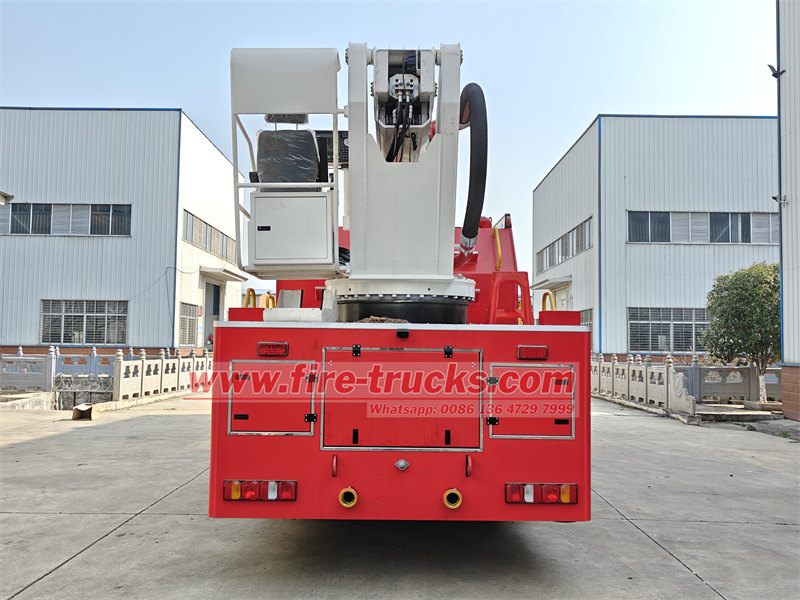
5. ระบบประปา
ระบบน้ำของ
รถดับเพลิงหอสูง HOWO
ถูกจัดวางใต้คานตามยาวในส่วนล่าง และตามแนวด้านนอกของบูมในส่วนบน เชื่อมต่อกับจอภาพระยะไกล มือจับควบคุมจอภาพติดตั้งอยู่บนคอนโซลควบคุมด้านบน รถบรรทุกมีปั๊มดับเพลิงติดตั้งอยู่ตรงกลาง ควบคุมผ่านแผงควบคุมด้านหน้า ซึ่งสูบน้ำจากแหล่งน้ำและจ่ายโดยตรงหรือจากถังเก็บน้ำบนรถ จากนั้นน้ำที่มีแรงดันจะถูกส่งไปยังจอภาพระยะไกล (หรือสายดับเพลิง) เพื่อใช้ในการดับเพลิง
6. ถังเก็บน้ำ
ถังน้ำทำจากสเตนเลสคุณภาพสูง มีช่องแบ่งทั้งแนวขวางและแนวยาวภายใน เพื่อเพิ่มความแข็งแรงและลดน้ำกระฉอก ด้านบนของถังมีช่องสำหรับเติมน้ำและบำรุงรักษา ปิดสนิทด้วยฝาปิด มีวาล์วระบายน้ำที่ด้านล่าง ช่วยให้ระบายน้ำได้หมดจดระหว่างการทำความสะอาดหรือซ่อมแซม
7. ระบบไฮดรอลิก
ระบบไฮดรอลิกส่วนล่างประกอบด้วยถังน้ำมันไฮดรอลิก ปั๊มเฟือง วาล์วตรวจสอบ วาล์วถ่ายโอน วาล์วควบคุมขาตั้ง และระบบปั๊มฉุกเฉิน วาล์วควบคุมทิศทางบนวาล์วควบคุมขาตั้งทำหน้าที่ควบคุมการเคลื่อนที่ของขาตั้ง วาล์วถ่ายโอนทำหน้าที่ประสานกันระหว่างวงจรไฮดรอลิกส่วนบนและส่วนล่างเพื่อการควบคุมตามลำดับและความปลอดภัย
วาล์วควบคุมขาตั้งทำงานร่วมกับวาล์วควบคุมทิศทางด้านบนเพื่อยืดหรือหดกระบอกสูบขาตั้งทั้งแนวนอนและแนวตั้ง สามารถควบคุมขาตั้งทั้งหมดพร้อมกันหรือแยกกันเพื่อปรับระดับรถอย่างแม่นยำ
8. กลไกการหมุนและการยกตัว
กลไกการหมุนขับเคลื่อนด้วยมอเตอร์ไฮดรอลิกและตัวลดรอบแบบดาวเคราะห์ ช่วยให้การหมุนราบรื่นและล็อคตัวเอง กลไกการยกตัว (luffing) ใช้กระบอกสูบยกตัวคู่ ร่วมกับวาล์วปรับสมดุลการยกตัวและตัวล็อกไฮดรอลิกแบบสองทิศทาง เพื่อการทำงานที่สอดประสานและปลอดภัย
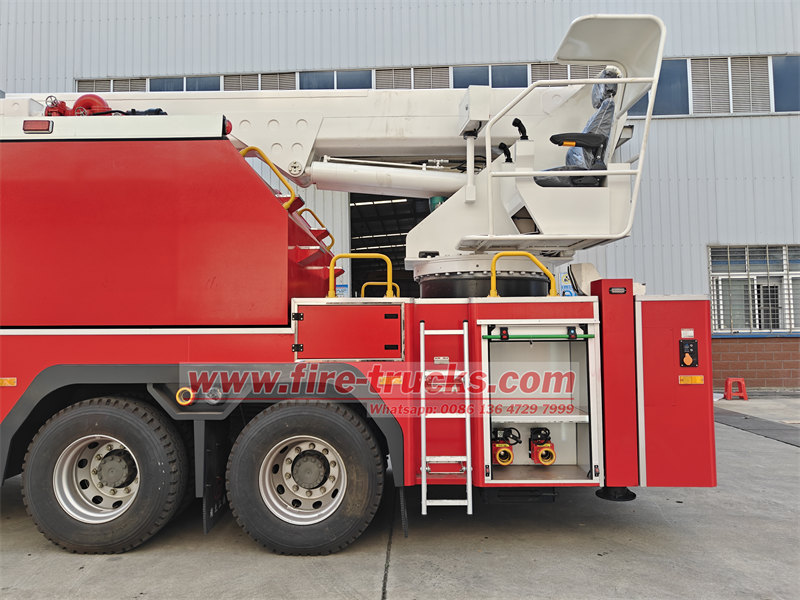
9. ระบบไฟฟ้า
ส่วนล่างประกอบด้วย:
• จอแสดงระดับของเหลวสำหรับถังน้ำและโฟม
• แผงควบคุมการทำงาน แผงหน้าปัด ไฟส่องสว่างด้านข้าง และระบบสัญญาณกันขโมยรถยนต์
• วาล์วลม: ควบคุมการเปิดและปิดวาล์วผีเสื้อโดยใช้กระบอกสูบลมเพื่อจ่ายน้ำไปยังจอภาพระยะไกล เติมน้ำในถัง หรือระบายน้ำ
• คอนโซลควบคุมและแผงหน้าปัดเครื่องมือ: ติดตั้งไฟแสดงสถานะ สวิตช์ ที่จับควบคุม หรือปุ่มต่างๆ โดยมีฉลากกำกับเพื่อความชัดเจน
• สัญญาณเตือนภัยรถยนต์: เปิดใช้งานไฟเตือนหมุนและไซเรนผ่านสัญญาณเตือนภัยอิเล็กทรอนิกส์และสัญญาณไฟในห้องโดยสารระหว่างการตอบสนองเหตุฉุกเฉิน
ส่วนบนประกอบด้วย:
• ระบบควบคุมความปลอดภัยบูม
• คอนโซลควบคุมการทำงาน
• การควบคุมจอภาพระยะไกล
• จอภาพระยะไกล: สามารถใช้งานได้ผ่านปุ่มบนคอนโซลหรือรีโมทไร้สาย รองรับโหมดการพ่นน้ำตรง การพ่น การฉีดน้ำ หรือการฉีดโฟม พร้อมมุมที่ปรับได้สำหรับการดับเพลิงเป้าหมาย
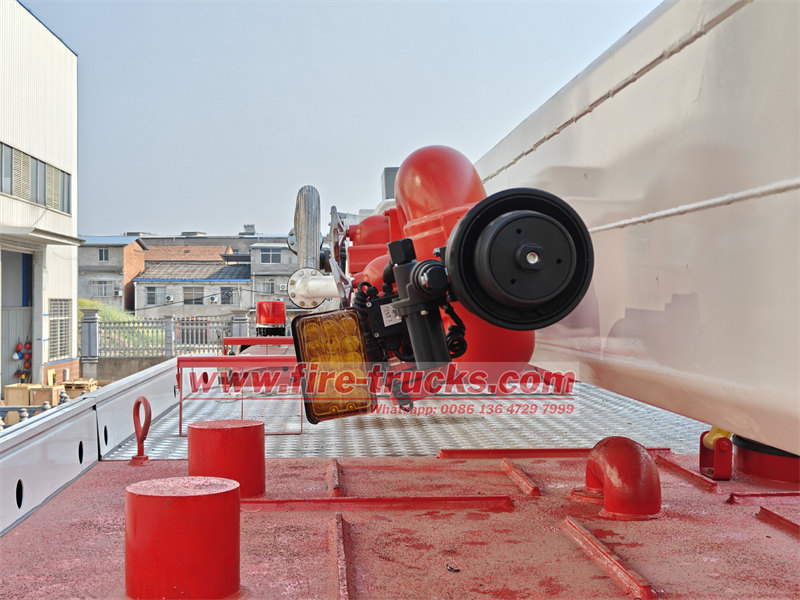
คุณอาจสนใจข้อมูลต่อไปนี้